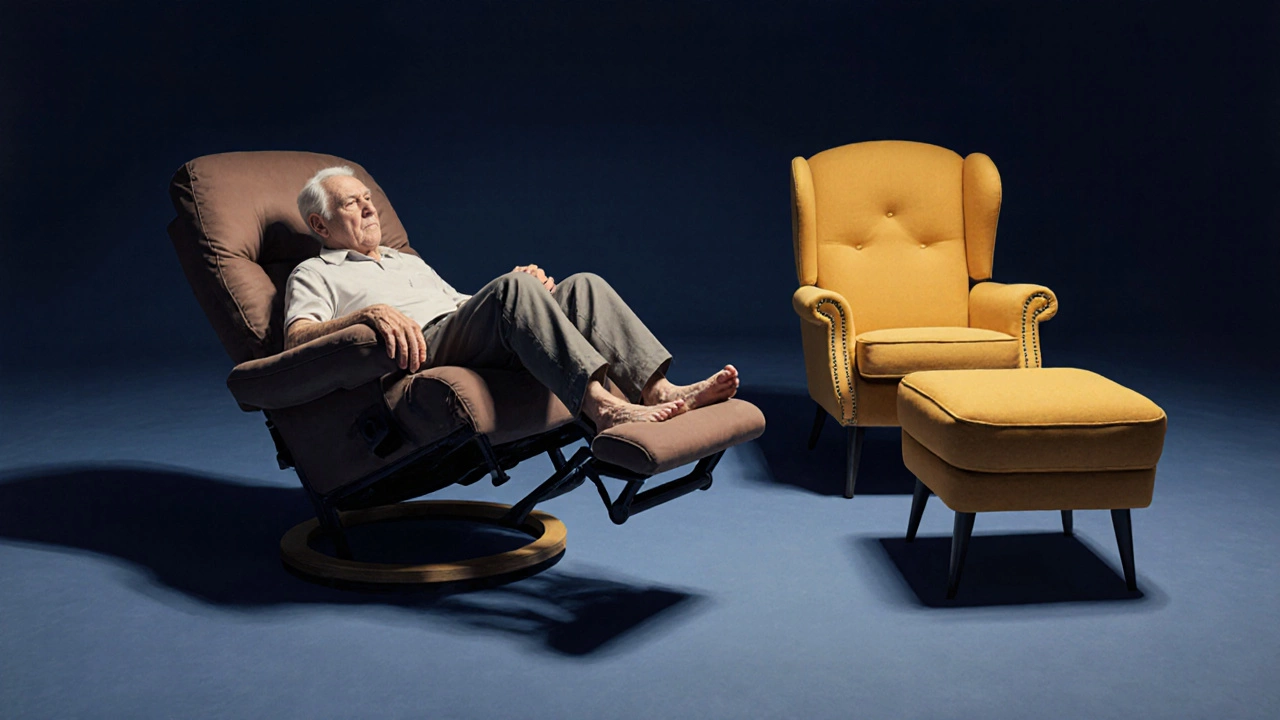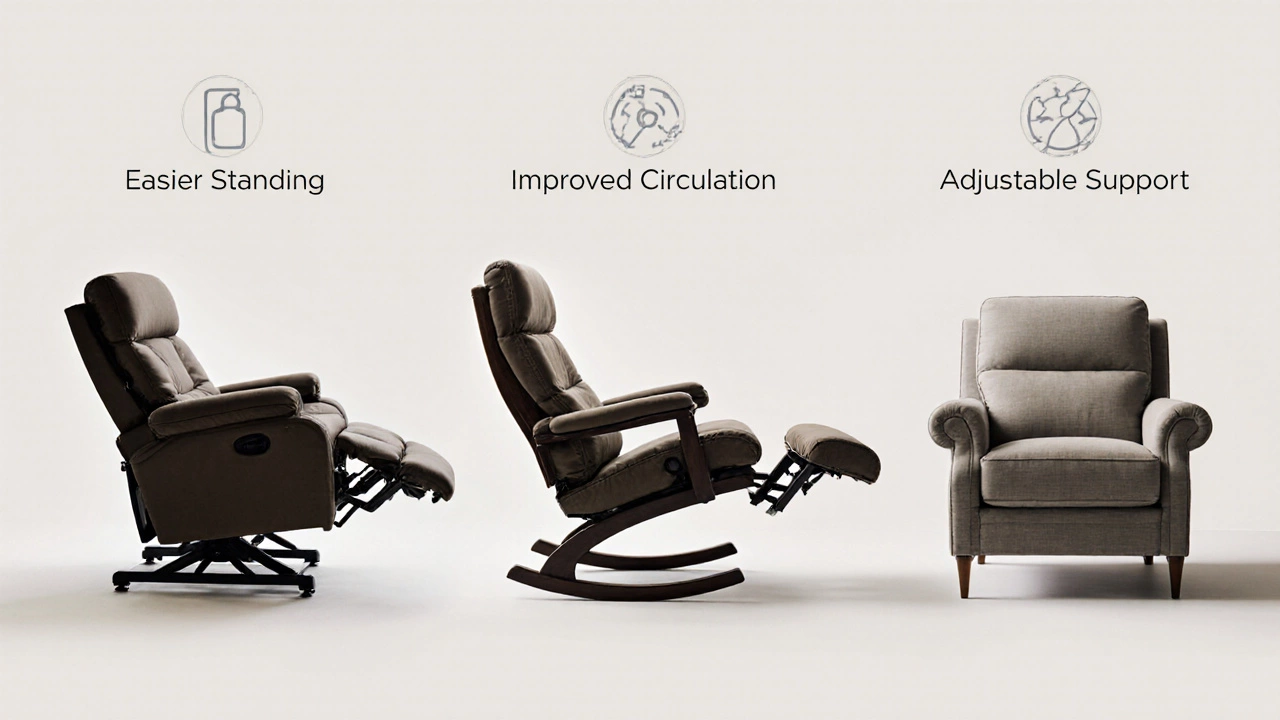Many seniors rely on recliners for comfort, but a growing number of families worry: are these chairs actually doing more harm than good? The answer isn’t simple. Recliners aren’t inherently bad for seniors - but the wrong type, used the wrong way, can cause real problems. The key isn’t avoiding recliners altogether. It’s choosing the right one and using it safely.
Why Seniors Love Recliners
Recliners offer more than just soft cushioning. For older adults with arthritis, back pain, or poor circulation, a good recliner can be a lifeline. The ability to elevate the legs reduces swelling in the feet and ankles - something doctors often recommend for people with venous insufficiency or heart conditions. The reclined position also takes pressure off the lower spine, which can ease discomfort from degenerative disc disease or spinal stenosis.
Many seniors find it easier to stand up from a recliner than from a flat sofa. Recliners with power lift mechanisms gently raise the user to a near-standing position, reducing strain on knees and hips. A 2023 study from the University of Leeds’ Aging Research Center found that seniors using lift recliners reported 40% fewer falls during transitions from sitting to standing compared to those using standard sofas.
The Hidden Risks
But not all recliners are created equal. Some designs do more harm than good. The biggest issue? Poor support. Many budget recliners have shallow seat depths and lack lumbar support. When seniors sit too far back, their spine curves unnaturally. Over time, this leads to chronic lower back pain and poor posture.
Another problem is getting stuck. If a recliner is too low, too soft, or too wide, it becomes hard to push up from. Seniors with muscle weakness or balance issues may struggle to rise without help. In extreme cases, people have spent hours trapped in recliners after falling asleep - a real risk with deep, cushion-heavy models.
Then there’s the footrest. Some recliners force the legs into an awkward angle, which can pinch nerves or restrict blood flow. If the footrest doesn’t adjust to leg length, it can cause knee or calf discomfort. One 78-year-old woman in Bradford told her physiotherapist she stopped using her recliner after her knees started tingling - the footrest was pressing into the back of her calves.
What Makes a Recliner Safe for Seniors?
Not all recliners are risky. The safest ones share a few key features:
- Seat height of 18 to 20 inches - this matches the height of a standard dining chair and makes standing easier.
- Firm, supportive cushioning - memory foam or high-density foam holds shape better than cheap polyester fill. Soft, sinking seats make it harder to rise.
- Adjustable lumbar support - a contoured backrest that supports the natural curve of the spine.
- Power lift mechanism - especially helpful for those with arthritis, hip replacements, or mobility issues.
- Adjustable footrest - should extend to match leg length without pushing behind the knees.
- Sturdy armrests - wide, padded, and at a height that lets you push up easily.
Brands like La-Z-Boy, Pride Mobility, and Golden Technologies make models specifically designed for seniors. Look for models labeled “bariatric,” “lift,” or “orthopedic.” These aren’t marketing buzzwords - they indicate real design choices that matter.

How to Use a Recliner Safely
Even the best recliner can be dangerous if used poorly. Here’s how to use one right:
- Don’t slouch - sit all the way back so your back touches the support. If you’re sliding forward, the chair is too deep.
- Keep feet flat on the footrest - if your toes hang off or your knees are bent sharply, adjust the footrest or switch chairs.
- Use the armrests to stand - push up with your arms, not your legs. This reduces strain on hips and knees.
- Avoid sleeping in it - if you doze off, move to a bed. Recliners aren’t designed for full-body support during sleep.
- Check for wear - frayed fabric, loose mechanisms, or squeaky parts can be hazards. Get it repaired or replaced.
One common mistake? Using a recliner as a permanent sitting spot. Seniors should change positions every 30 to 45 minutes. Sitting too long in any chair - even a good one - increases pressure on the tailbone and reduces circulation.
When to Avoid Recliners Altogether
There are cases where a recliner isn’t safe:
- If the senior has severe balance issues and no one is around to help them stand.
- If they’ve had a recent hip or knee replacement and their surgeon advised against reclining past 90 degrees.
- If they have advanced osteoporosis - deep reclining can increase spine compression.
- If the chair is too low or too soft to get out of without assistance.
In these cases, a stationary chair with a firm seat and high back, paired with a separate ottoman for leg elevation, may be safer. Some physical therapists recommend rocker recliners - they tilt gently without locking into a deep recline, making it easier to rise.

Alternatives to Traditional Recliners
Not every senior needs a full recliner. Here are three practical alternatives:
- Lift chairs - these are recliners with electric motors that raise the entire seat. Ideal for those with mobility challenges. Prices range from £600 to £1,500. Rocking recliners - the gentle motion helps with circulation and is easier to exit than fixed-position recliners.
- Zero-gravity chairs - designed to distribute weight evenly, these reduce pressure on the spine and improve breathing. Often used in medical settings.
Some seniors find that a simple armchair with a footstool works better than a recliner. It’s easier to get in and out of, and they can adjust the angle of their legs independently.
What Doctors and Therapists Recommend
Physical therapists in the UK consistently advise seniors to prioritize support over softness. “It’s not about how plush it feels,” says Dr. Helen Carter, a geriatric physiotherapist in Leeds. “It’s about whether the chair helps you move safely and maintain good posture.”
She recommends testing a recliner before buying:
- Sit in it for 10 minutes. Does your back feel supported, or do you slump?
- Try standing up without using your hands. Can you do it easily?
- Check the footrest. Does it stop before your knees? If it pushes into the back of your legs, walk away.
She also reminds families: “Don’t buy based on looks or price. Buy based on function. A £300 chair that causes pain isn’t a bargain.”
Final Thoughts
Recliners aren’t the enemy. For many seniors, they’re essential for comfort and independence. But choosing the wrong one can lead to pain, falls, or long-term posture problems. The goal isn’t to avoid recliners - it’s to pick the right one and use it wisely.
If you’re shopping for a senior, bring them with you. Let them test it. Ask them how it feels after sitting for 10 minutes. Watch how they stand up. If they hesitate, struggle, or complain of pressure, it’s not the right chair.
Good posture, safe movement, and easy access matter more than style or brand. A well-chosen recliner can improve quality of life. A bad one? It might just make things worse.
Are recliners good for seniors with back pain?
Yes - if the recliner has proper lumbar support and a firm seat. Reclining slightly takes pressure off the spine, which can ease pain from arthritis or disc issues. Avoid chairs that let you sink too far back. Look for models with adjustable back support and a seat depth that keeps your back fully supported.
Can recliners cause hip problems?
They can - if the chair is too low or too soft. Sitting too low forces the hips to bend past 90 degrees, which strains the joint, especially after hip replacement surgery. Choose a chair with a seat height of 18 to 20 inches. Test it: if the senior can’t stand up without using their arms, it’s too low.
Is a lift recliner worth the extra cost?
For seniors with mobility issues, yes. Lift recliners reduce the risk of falls by helping users stand safely. A 2023 study showed a 40% drop in fall-related injuries among users. While they cost more - between £600 and £1,500 - they can prevent hospital visits and long-term care costs. Many insurance plans cover them if prescribed by a doctor.
How long should a senior sit in a recliner?
No more than 30 to 45 minutes at a time. Sitting too long increases pressure on the tailbone and reduces blood flow. Encourage regular movement: stand up, walk around, stretch. Even small shifts in position help. A timer or reminder app can help seniors avoid staying seated too long.
What’s the difference between a recliner and a lift chair?
A recliner tilts back but doesn’t raise the seat. A lift chair has a motor that lifts the entire seat upward, helping users stand. Lift chairs are better for those with weak legs, arthritis, or balance issues. Recliners are fine for those who can still stand easily. Lift chairs cost more but offer greater safety.
Can sleeping in a recliner hurt a senior?
Yes. Recliners don’t support the full spine during sleep. Sleeping in one can cause neck strain, poor breathing, and pressure sores. It also increases the risk of being stuck if they fall asleep and can’t get up. If a senior prefers to nap in a recliner, make sure someone checks on them regularly and encourage them to move to a bed for overnight sleep.
If you’re helping a senior choose a recliner, don’t rush the decision. Try out at least three models. Bring a cane or walker if they use one. Ask questions. Watch how they move. The right chair doesn’t just look good - it lets them sit comfortably, stand safely, and live independently.



